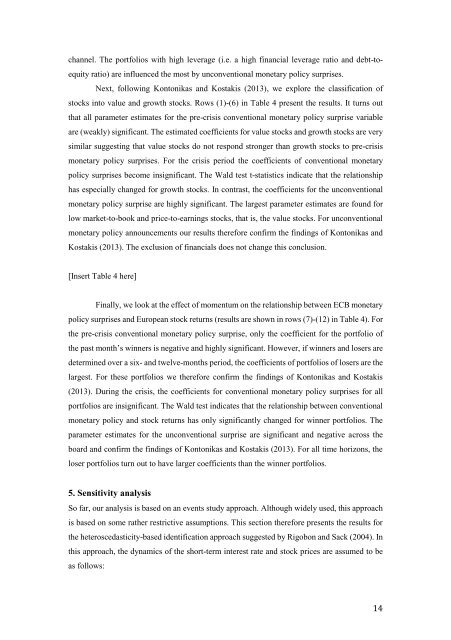DNB Working Paper
n?u=RePEc:dnb:dnbwpp:483&r=all
n?u=RePEc:dnb:dnbwpp:483&r=all
You also want an ePaper? Increase the reach of your titles
YUMPU automatically turns print PDFs into web optimized ePapers that Google loves.
channel. The portfolios with high leverage (i.e. a high financial leverage ratio and debt-toequity<br />
ratio) are influenced the most by unconventional monetary policy surprises.<br />
Next, following Kontonikas and Kostakis (2013), we explore the classification of<br />
stocks into value and growth stocks. Rows (1)-(6) in Table 4 present the results. It turns out<br />
that all parameter estimates for the pre-crisis conventional monetary policy surprise variable<br />
are (weakly) significant. The estimated coefficients for value stocks and growth stocks are very<br />
similar suggesting that value stocks do not respond stronger than growth stocks to pre-crisis<br />
monetary policy surprises. For the crisis period the coefficients of conventional monetary<br />
policy surprises become insignificant. The Wald test t-statistics indicate that the relationship<br />
has especially changed for growth stocks. In contrast, the coefficients for the unconventional<br />
monetary policy surprise are highly significant. The largest parameter estimates are found for<br />
low market-to-book and price-to-earnings stocks, that is, the value stocks. For unconventional<br />
monetary policy announcements our results therefore confirm the findings of Kontonikas and<br />
Kostakis (2013). The exclusion of financials does not change this conclusion.<br />
[Insert Table 4 here]<br />
Finally, we look at the effect of momentum on the relationship between ECB monetary<br />
policy surprises and European stock returns (results are shown in rows (7)-(12) in Table 4). For<br />
the pre-crisis conventional monetary policy surprise, only the coefficient for the portfolio of<br />
the past month’s winners is negative and highly significant. However, if winners and losers are<br />
determined over a six- and twelve-months period, the coefficients of portfolios of losers are the<br />
largest. For these portfolios we therefore confirm the findings of Kontonikas and Kostakis<br />
(2013). During the crisis, the coefficients for conventional monetary policy surprises for all<br />
portfolios are insignificant. The Wald test indicates that the relationship between conventional<br />
monetary policy and stock returns has only significantly changed for winner portfolios. The<br />
parameter estimates for the unconventional surprise are significant and negative across the<br />
board and confirm the findings of Kontonikas and Kostakis (2013). For all time horizons, the<br />
loser portfolios turn out to have larger coefficients than the winner portfolios.<br />
5. Sensitivity analysis<br />
So far, our analysis is based on an events study approach. Although widely used, this approach<br />
is based on some rather restrictive assumptions. This section therefore presents the results for<br />
the heteroscedasticity-based identification approach suggested by Rigobon and Sack (2004). In<br />
this approach, the dynamics of the short-term interest rate and stock prices are assumed to be<br />
as follows:<br />
14




